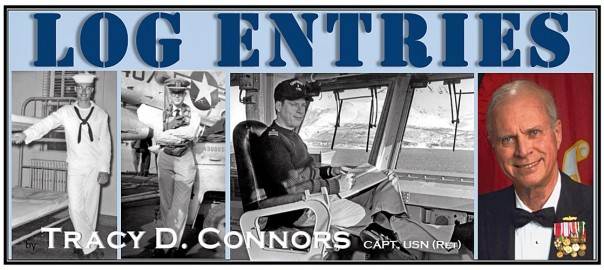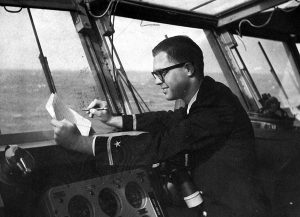
The Captain’s Night Orders are directives prepared by Commanding Officers for watch standers regarding the safety of the ship when they are not on the bridge, typically when they are resting or asleep.
U.S. Navy Regulations require Commanding Officers to prepare instructions for the Officer of the Deck who will be responsible for the navigation and maneuvers of the ship, in addition to the ship’s routine.
Before relieving the Officer of the Deck Underway (OOD u/w), the on-coming OOD was required to prepare himself thoroughly. Reading and initialing the Captain’s Night Orders was an important step in the relieving process. They were read and initialed before every watch between 2100 – 0800. In other words, periods when the Captain might be away from the bridge.
When the ship was underway, the Captain slept in the “Sea Cabin,” a small compartment abaft the Navigation spaces behind the Bridge. It included a small desk, bunk, head, and a “voice tube” connected directly to the bridge. Theoretically, this allowed the OOD to “call” him in any emergency. In practice, he was so tired from the frequent 18+ hour work days that were SoP for all hands, he slept so soundly that I would have to leave the bridge for a few moments to knock on the Sea Cabin door, wake him with the report, get his orders, then race back to the bridge. This only took a few moments. Had there ever been a true crisis, I would never have left the bridge, but dealt with it first and advised him ASAP. Fortunately, vigilance and a well-trained watch team ensured we never even came close to putting the ship in such a position.
From just prior to flight quarters in the morning, about 0800, until we secured from flight quarters about 2200, the Captain was almost always on the bridge and available for instant consultation by the OOD. Of course, he could at any time simply announce to the Bridge watch team, “I have the Deck and the Conn.” He was then directly controlling the ship (conn) and the ship’s daily routine (deck). This was very rare. Usually, he would simply tell the OOD what he wanted to happen, and the OOD would “Aye, Aye, Sir,” and make it happen through orders to the appropriate Watch Team member.
As noted below, the Captain’s Night Orders were explicit in detailing how the watch was to be stood, and under what conditions the Captain was to be notified about situations that needed a command decision.
In particular note Paragraph 4 (l), “When another vessel is sighted…” Any contact — and between our radars, four lookouts changed every hour, and the bridge watch team that meant ALL vessels within about a twenty mile radius of the ship — was required to be tracked and analysed regarding its movements and whether there was ANY danger WHATSOEVER to our ship.
The Night Orders officially state 5,000 yards (2.5 nautical miles) as the Closest Point of Approach (CPA) allowed. In practice, it was 10,000 yards, or further. Unless it was one of ours (enabling radio communications), or an allied ship operating with us, we did not want other ships within about ten miles. This would give us maneuvering room.
We would always try to compute a course, speed, or maneuver that would avoid our being designated the Privileged vessel, the ship that had to maintain course and speed under the International Rules of the Road. “Being Privileged is no Privilege,” was the motto. We would much rather be required to maneuver since we knew what we were doing, but you never knew who was on the bridge of the “Burdened” vessel, or even IF there was anyone on the bridge at all, much less paying attention to maneuvering their ship.
Most prudent course of action, give them all a very wide berth.
After reading these Night Orders you can better appreciate what training, attention to duty, and vigilance was required by underway watch standers in those days. What has changed since then that has resulted in the recent tragic collisions between U.S. Navy ships and other vessels?
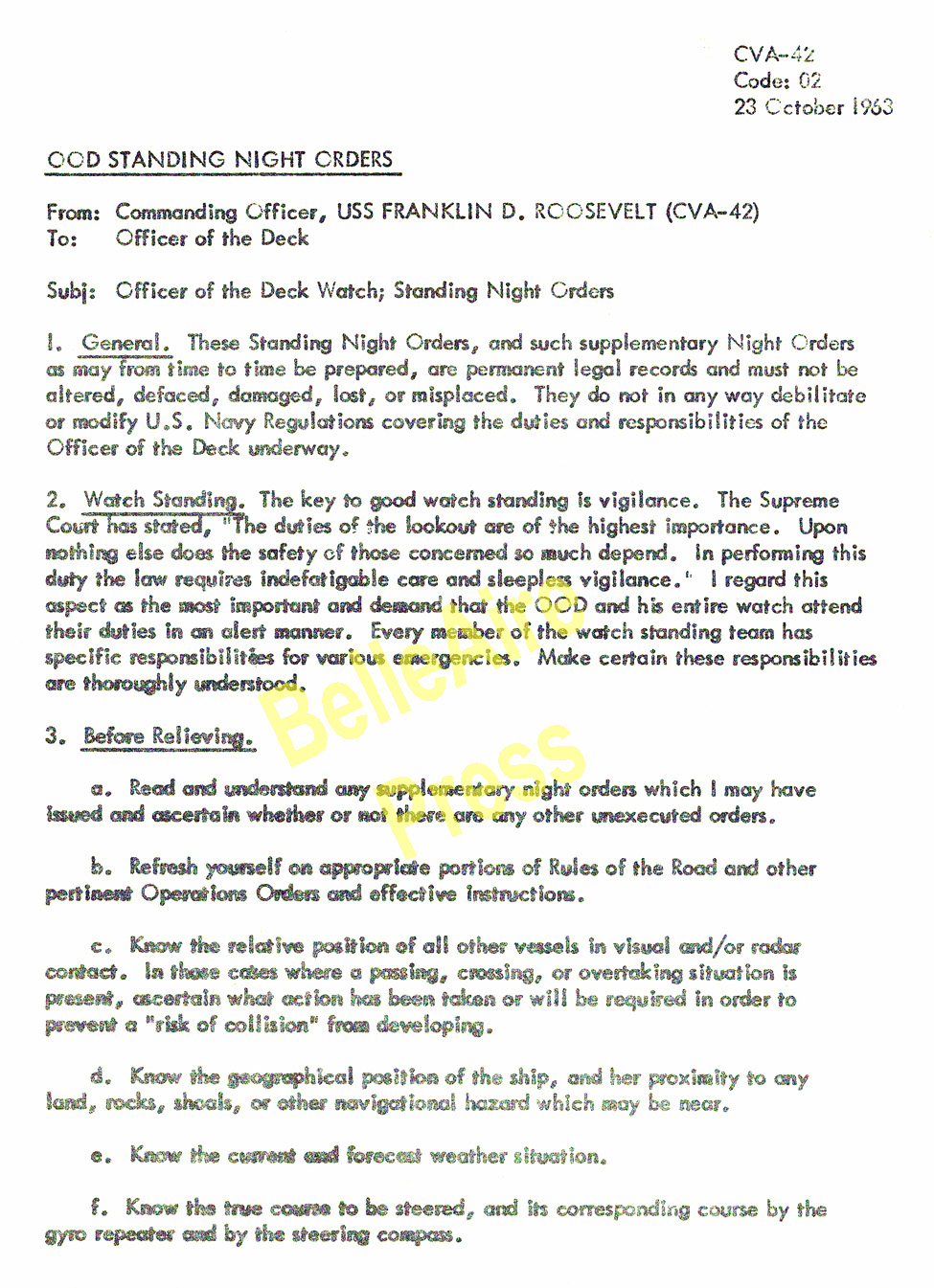
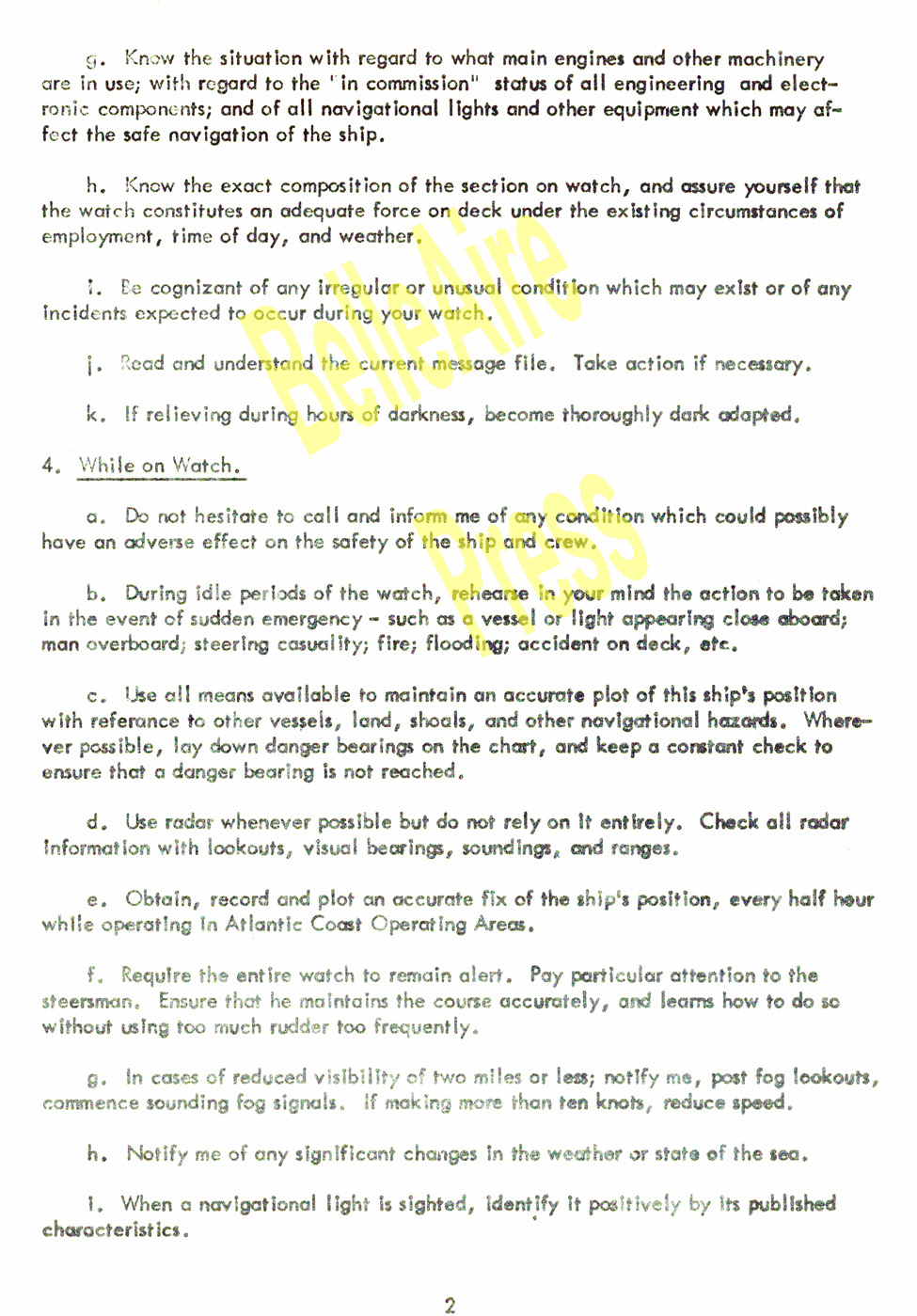
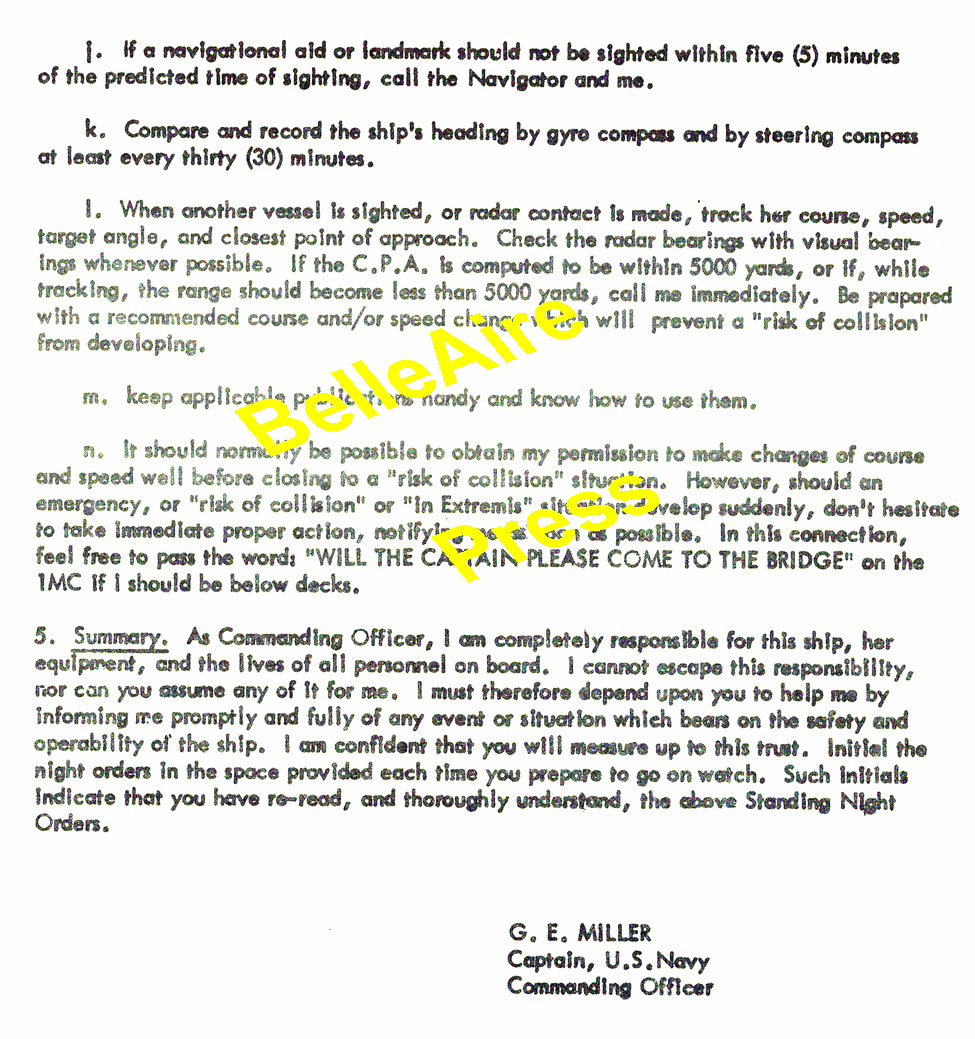
© Copyright 2017-2022 BelleAire Press
Other works by Dr. Connors…
Baited Trap, the Ambush of Mission 1890
Now Available As E-Pub

Baited Trap, The Ambush of Mission 1890 is the story of helicopter rescue Mission 1890, one of the most heroic—and costly—air rescues of the Korean War. This harrowing Air Force-Navy mission is explained in compelling detail, creating a detailed personal account of what five incredibly brave and determined Air Force and Navy airmen achieved on June 25, 1952 in the infamous “Iron Triangle.”
The Korean War’s Greatest Love Story
Baited Trap is much more than a heroic war story from the “forgotten war.” It is also the Korean War’s greatest love story, following Wayne and Della Lear, Bobby Holloway, Ron Eaton and Dolly Sharp, and Frankie and Archie Connors as they tried to put their lives and families together even as the Korean War was reaching out to engulf them.
Truckbusters From Dogpatch: the Combat Diary of the 18th Fighter-Bomber Wing in the Korean War, 1950-1953

Truckbusters from Dogpatch is the most comprehensive Korean War unit history yet prepared–over 700 pages summarizing squadron histories and first person accounts—and includes over 1,000 never before published photographs and images, highlighted by the 8 ½ x 11-inch format.
Arguably, Truckbusters From Dogpatch is the most authoritative unit history ever prepared on the Korean War. In addition to consulting formerly classified squadron histories filed monthly throughout the conflict, the author was in touch with hundreds of veterans of the 18th—pilots and ground crew—whose personal recollections add vivid detail and emotion to the facts recounted in the official documents.
Recent Log Entries by CAPT Connors…
Carrier Captain’s Night Orders: “Call Me…”
After reading these Night Orders you can better appreciate what training, attention to duty, and vigilance was required by underway watchstanders in those days. What has changed since then that has resulted in the recent tragic collisions between U.S. Navy ships and other vessels?
“We do it all!” (USS Saipan LHA-2 motto)
Saipan CO, CAPT Jack Renard, was not exaggerating when he noted that “without exception, SAIPAN is the most versatile instrument of peace or war on the seas today.” Like its motto pointed out, SAIPAN could do it all.
In Dire Straits of Gibraltar
I had never taken the ship (aircraft carrier F. D. ROOSEVELT) through the Straits before as the OOD. Now I was expected to do so while the rest of the ship—including the Captain—was fast asleep.
U.S. Navy and back to the future Star Power
The reliance today by U.S. Navy afloat units on satellites and highly complex electronics, all of which are vulnerable to compromise or destruction by an enemy, can also leave us highly vulnerable, particularly if our ships and Surface Warfare Officers are not trained in more traditional methods of navigation and seamanship.
Losing satellites could badly compromise or eliminate satellite navigation. Funny, I trusted the star fixes, but the GPS readings that came later, were suspect. As this Log Entry points out, satellites are vulnerable. They can be hacked or “taken out” in a variety of ways.
But with training, a sextant, the right tables and a handful of stars or a noon day sun, the cosmos will tell you where you are on planet Earth.
Soot, as a weapon? Recalling the Mediterranean Cold War in the Sixties
The watch team cheered, we even heard cheering from PriFly aft of our level. The Captain was happy, the bridge watch team was ecstatic. The Russians on our tail? Not so much! Main Control had “gotten into the War,” and I wrote in the ROOSEVELT’s deck log: “Blew tubes at 1430.”
The In-Port Watch on a U.S. Navy aircraft carrier in the Sixties
Any questions?”
“Not that I can think of,” I replied, then added the required legal response: “I relieve you Sir.”
The fateful words are spoken. From this point on, anything that happens on this watch will be my responsibility.
“Very well, I stand relieved. Quartermaster, LTJG Connors has the deck,” the now off-watch OOD announced to the Watch Team.
I, in turn, step back out onto the quarterdeck to take a look around to see if there are any boats headed towards the ship.
The air is very cold, but refreshing, in small doses.
The far off boats of Cannes, swing in the breeze.
At this distance, the beautiful city rolls itself like a white wave, far into the hills. On the distant horizon, covers the mountains like a picture post card.
Memories of the Fru Dee Roo
When the USS Franklin D. Roosevelt (CV A-42) was towed toward the oblivion of the scrap yard in 1978, she consisted of some 65,000 tons of obsolete steel and equipment–but she left many more tons of memories with the tens of thousands of Navy men who had served aboard her during her 32 years of commissioned service.
The “Rosy” or “Fru Dee Roo” or “Rusty Bucket” to those of us who alternately cussed her amongst ourselves and who fought for her honor with outsiders, was more than just a ship. She was home for some 4,000 men–a floating “town” some 1,000 feet long with over 500 miles of wiring, 150 television receivers, 111 storerooms where some 81,000 items were kept in readiness, and with 12 oil-fired steam boilers that drove it at speeds up to 32 knots. A bit of a “gas hog,” the ship’s boilers burned some four million gallons of fuel per month on average. This “town” carried over 70 warplanes of many types and could launch them at a rate of two per minute.
We were “the stick” in case the “talk softly” part was not successful.
What The Hell Flag Signal
The day the ROOSEVELT got the What the Hell Flag Signal. As the OOD, you knew you had really screwed things up when an oiler gave you the “What the Hell” Flag Signal.
On this afternoon, as we were making our high speed approach on the oiler, the Captain suddenly announced that he had the conn (was maneuvering the ship himself), then announced that Commander “Neversail” had the conn. I was amazed. I assumed that he wanted the new Navigator to get some experience, but to actually let him maneuver the ship (with the Captain making “recommendations” while standing right beside him), was risky as we were barreling down on the unsuspecting oiler. “Things” didn’t go well, as they say.
